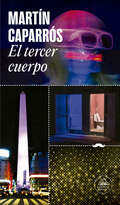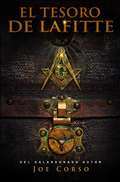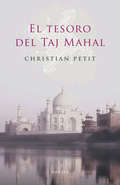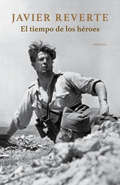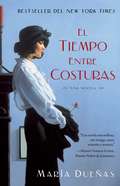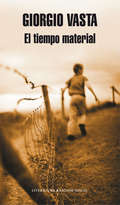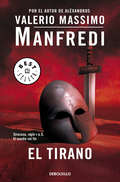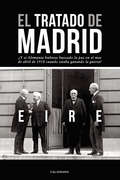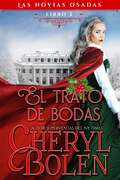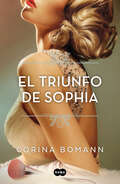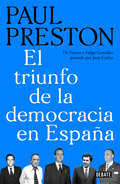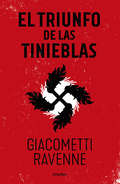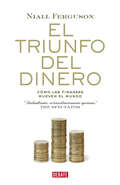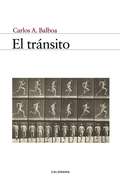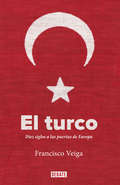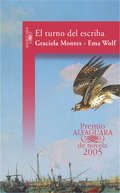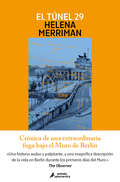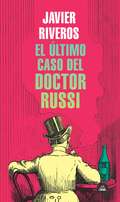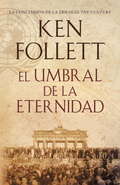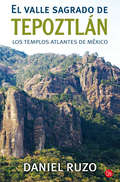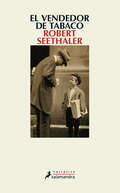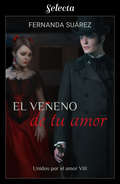- Table View
- List View
El tercer cuerpo
by Martín CaparrósUn policial negro con el Bar Británico, el puente de Pompeya y la discoteca Palladium. En los baños de la mítica discoteca Palladium, Matías Jáuregui, el hijo algo verde de un rancio coronel, escucha una conversación susurrada sobre el escándalo del momento: la profanación de tres tumbas del cementerio de la Recoleta. Para tratar de justificar su membrete de «relaciones públicas», y hacer algún dinero, se le ocurre ofrecer sus servicios a Rafael López Aldabe, pariente de uno de esos cadáveres y, a la vez, turbio empresario al que su propio padre debe favores confusos. Con escenarios tan porteños como el Bar Británico, la Academia y el puente de Pompeya, El tercer cuerpo es una novela ribeteada de humor que, entre dealers, burros, merca y sexo raro, recorre tanto los círculos del hampa como los más tradicionales de una Buenos Aires altamente inflamable bajo la luz siempre incendiaria de los años ochenta. Críticas:«El tercer cuerpo de Caparrós puede considerarse como uno de los textos representativos del policial negro argentino».Martha Barboza, Universidad Nacional de Salta «Las ciudades inmensas y grises son las protagonistas de su obra, que destapan las desigualdades sociales de sus habitantes».Daiane Nora, El País«Su prosa y su mirada son un reactivo fuerte para almas sensibles o amigas de lo políticamente correcto».Leila Guerriero, El País «Caparrós provoca esa necesidad sonriente de subrayar, compartir en redes, reproducir sus trallazos"».Nadal Suau, El Cultural «Convence tanto como seduce».Edmundo Paz Soldán, La Tercera«Un perturbador sistemático, un sembrador de dudas».Francesca Lazzarato, Il Manifesto
El tesoro de Lafitte
by Joe Corso M ª Carmen OliveroUna búsqueda por el tesoro del legendario pirata que abarcó 200 años. Los británicos ofrecieron a Jean Lafitte la Capitanía en la Marina Británica junto a una gran cantidad de tierras, títulos y 30.000 dólares en oro si aceptaba unirse a ellos para luchar contra los Estados Unidos. Con todo ésto, ¿por qué Lafitte rechazó su generosa oferta? Aproximándose la Guerra de 1812, el General Andrew Jackson no tiene armas, munición ni dinero para lucar contra los británicos y nadie a quien acudir en busca de ayuda excepto el famoso pirata Jean Lafitte. Jackson odia a los piratas pero accede encontrarse con Lafitte y forma una alianza única con el apuesto pirata. ¿Qué hizo cambiar de idea a Jackson a la hora de decidir acudir a la reunión? Antes de que la guerra comience, Lafitte entierra un tesoro especial, uno que se buscará en el siglo XXI por dos hombres y una hermosa mujer. Julianna Montaigne, una descendiente directa de Pierre Lafitte, ha encontrado su diario en el viejo baúl de su abuelo, un viejo lobo de mar. El diario tiene una pista para encontrar el tesoro. Eddie Calto, un bombero de la ciudad de Nueva York, tiene una segunda pista que su tatarabuelo le dejó. Los dos unen sus fuerzas para encontrar el Tesoro de Lafitte. Pero hay hombres peligrosos que quieren el tesoro para ellos y durante 200 años han esperado pacientemente a que alguien empezara a buscar el Tesoro de Lafitte.
El tesoro del Taj Mahal
by Christian PetitEl extraordinario periplo por la India de la princesa Sanjana en busca de su marido. India, 1633. En plena construcción del Taj Mahal, el misterioso Amritlal planea el robo de las piedras preciosas destinadas a embellecer el mausoleo. Para ello, no duda en seducir a la princesa Sanjana, esposa del joyero francés encargado de las obras y recientemente desaparecido. Cuando Amritlal es apresado, Sanjana debe emprender un emocionante viaje a través de la India para encontrar a su esposo y lograr así defender su honor y salvar el Taj Mahal. Una apasionante aventura que arrastra al lector a los lejanos y exóticos confines asiáticos.
El tiempo de los héroes
by Javier ReverteLa biografía novelada de Juan Modesto, uno de los jefes de las milicias comunistas, recoge toda la épica y la tragedia de la Guerra Civil española. Una de las mejores historias escritas sobre el conflicto. Por Javier Reverte. Marzo de 1939. A punto de caer Madrid y tras las derrotas del río Ebro y Cataluña, el ejército republicano se desploma mientras las tropas franquistas avanzan hacia Levante, a la conquista de los últimos bastiones de la Segunda República. En el pueblo de Petrel (Alicante), el gobierno de Juan Negrín y buena parte de los dirigentes del Partido Comunista preparan su salida de España. Y hasta allí llega el general Juan Modesto para organizar, junto con otros jefes militares republicanos, la evacuación del gobierno. Son los últimos días de la guerra y los recuerdos se agolpan en la mente de Modesto. Por su memoria desfilan los días de su infancia, las alegres jornadas del Madrid que resistía el avance del fascismo, sus amores, los combates del Quinto Regimiento y de las Brigadas Internacionales, todas las batallas que le convertirían en una leyenda: el Jarama, Brunete, Belchite, Teruel, el Ebro, Cataluña... El Juan Modesto de la realidad histórica se convierte, en esta novela, en un personaje que alcanza la dimensión de los guerreros de antaño, de los héroes clásicos.
El tiempo entre costuras: A Novel (Atria Espanol)
by Maria DuenasLa joven modista Sira Quiroga abandona el Madrid agitado de los meses previos al alzamiento arrastrada por el amor desbocado hacia un hombre a quien apenas conoce. Con él se instala en Tánger, una ciudad exótica y vibrante donde todo puede suceder. Incluso la traición. Sola, desubicada y cargada de deudas ajenas, Sira se traslada a Tetuán, capital del Protectorado Español en Marruecos. Gracias a la ayuda de nuevas amistades forjará una nueva identidad y logrará poner en marcha un taller de alta costura en el que atenderá a clientas de orígenes lejanos y presentes insospechados. A partir de entonces, con los ecos de la guerra europea resonando en la distancia, el destino de Sira queda ligado al de un puñado de carismáticos personajes que la empujarán hacia un inesperado compromiso en el que las artes de su oficio ocultarán algo mucho más arriesgado. El tiempo entre costuras es una novela de amor, de ritmo imparable cargada de encuentros y desencuentros, de identidades encubiertas y giros inesperados; de ternura, traiciones y ángeles caídos.
El tiempo material
by Giorgio VastaEl tiempo material es una novela extrema, inteligente y que se ha impuesto en Italia como la primera novela de un joven escritor especialmente talentoso. Sicilia, 1978: Italia atraviesa uno de los periodos políticos más convulsos de su historia. Aldo Moro, primer ministro italiano y líder de la Democracia Cristiana, ha sido secuestrado por las Brigadas Rojas. Tras sesenta días de cautiverio, es hallado asesinado en el maletero de un coche en pleno centro de Roma. El tiempo material es, a este nivel, una alegoría política escrita con un pulso narrativo feroz que recuerda a Leonardo Sciascia o Pier Paolo Pasolini. Ante este panorama tres jóvenes amigos, Nimbo, Raggio y Volo, deciden seguir de cerca el caso Aldo Moro. En sus mentes adolescentes los brigadistas son guerreros, magos que luchan por una Italia mejor. Las vidas de los tres amigos transcurren en una aparente normalidad, pero cuando están a solas desprecian a los italianos por su apatía y su cinismo, un odio que les llevará a cometer oscuros actos de los que terminarán arrepintiéndose. Reseña:«Una perturbadora parábola sobre los abusos del poder político.»Relevant
El tirano
by Valerio Massimo ManfrediEsta es la historia de Dionisio de Siracusa, dramaturgo y hombre de estado, lleno de pasión y con una personalidad enérgica y controvertida, que formó el ejército más grande de la antigüedad. Sicilia, siglo v a.C. El guerrero más audaz de Siracusa tiene una sola ambición: liberar la isla de los cartagineses y fortalecer el dominio griego. De este modo comienza la prodigiosa aventura de Dionisio I, tirano de Siracusa, temido por quienes se oponían a su política y amado por todos aquellos que vieron cómo Siracusa se convertía en la ciudad más próspera del mundo griego, embelleciéndose con magníficos monumentos que aún se conservan. El tirano es el retrato de una personalidad fascinante en sus odios y sus amores, en sus éxitos y sus fracasos. También es un retazo de la historia de Grecia, con sus glorias, el esplendor de sus ciudades, sus batallas y asedios, narrada con tal vivacidad que es capaz de arrastrar al lector a aquellos tiempos de dioses y héroes. Reseña:«Otro personaje histórico formidable, Dionisio de Siracusa, renace bajo la pluma de Valerio Massimo Manfredi.»El País
El tratado de Madrid
by Eire¿Y si Alemania hubiese buscado la paz en el mes de abril de 1918 cuando estaba ganando la guerra? En abril de 1918, mientras los ejércitos alemanes avanzan victoriosos en el frente occidental, el general en jefe de los mismos, Erich Ludendorff, sufre un inesperado ataque de apoplejía al descubrir el cadáver de su hijo en una visita rutinaria al frente. Esta situación posibilita que sectores menos belicistas, y más realistas dentro del ejército y la política alemana, puedan imponer sus tesis sobre la necesidad de obtener una paz negociada, cuando todavía los ejércitos americanos no han llegado a desembarcar en masa en Francia. Finalmente, un armisticio entre los contendientes se alcanza y todas las naciones quedan citadas a una futura conferencia de paz para resolver todas sus diferencias, a celebrarse en Madrid. Berlín, París, Londres, Berna y finalmente Madrid son el escenario de intrigas, aventuras y romances que tendrán que desembocar en la firma de un tratado que ponga fin a la guerra más cruenta que haya conocido Europa. Bajo este trasfondo, dos espías alemanes, un ministro inglés, una princesa rusa refugiada en España y un abogado español verán arrastradas sus vidas en el torbellino de esta conferencia, de la que todos intentarán obtener el mejor provecho particular.
El trato de bodas: Un matrimonio por conveniencia navideño (Las novias osadas #2)
by Cheryl BolenPara salvar a su hermano, la encantadora Lady Fiona Hollingsworth se ofrece osadamente a sí misma al hombre más rico del reino. Él no es alguien que se mueve entre sus círculos y solo lo conoció una vez, pero no puede sacarse al apuesto plebeyo de sus pensamientos. Nicholas Birmingham está acostumbrado a que las mujeres caigan a sus pies, pero ¿qué la hermosa Lady Fiona Hollingsworth lo haga? Rechaza su propuesta, pues se prometió a sí mismo casarse por amor, y es consciente que Lady Fiona no está enamorada de él. Sin embargo, cuando se da cuenta que ella se ofrecerá a sí misma a otro hombre, se da por vencido. Le pide su mano en matrimonio y que ella le entregue de forma complaciente cuerpo en la cama.
El triunfo de Sophia (Los colores de la belleza #Volumen 3)
by Corina BomannEl destino de Sophia se decide en la cautivadora última entrega de la trilogía best seller de Corina Bomann.Nueva York, 1934. Sophia se encuentra de nuevo en una encrucijada. Durante años, las dos emperatrices del maquillaje, Helena Rubinstein y Elizabeth Arden, se han peleado por su talento arrastrándola en su batalla. Ahora Sophia sueña con independizarse y crear su propia empresa, pero cuando su amiga Henny acude a ella gravemente enferma, la necesidad de ayudarla le hará llamar de nuevo a la puerta de madame Rubinstein. Y aunque en el amor parece que la vida le sonríe, las noticias de la guerra en Europa son cada vez más inquietantes... y amenazan el futuro que anhela construir.En un emocionante final lleno de sorpresas, Sophia tendrá que luchar con todas sus fuerzas para reunirse con el hombre que ama y realizar finalmente sus ambiciones.
El triunfo de la democracia en España: De Franco a Felipe González pasando por Juan Carlos
by Paul PrestonNueva edición actualizada del clásico texto de Preston sobre la transición y la consolidación de la democracia española. En esta obra, Paul Preston recorre el camino que pasa por la desintegración del franquismo, la muerte de Carrero Blanco, la etapa de gobierno de Arias Navarro, la llegada de Adolfo Suárez y la reforma política emprendida, la construcción de una democracia con elementos del viejo régimen, los intentos de golpe de estado y la intervención crucial del rey Juan Carlos en todo el proceso que hizo posible el restablecimiento y la consolidación de la democracia en España.
El triunfo de las tinieblas (Trilogía Sol negro #Volumen 1)
by Jacques Ravenne Eric GiacomettiLos nazis recorren el mundo en busca de cuatro reliquias que convertirán el Tercer Reich en un poder milenario. El eterno combate entre el Bien y el Mal. Tíbet, enero de 1939. Una expedición de las SS se apodera de una esvástica tallada en un metal desconocido. Es una de las reliquias que simbolizan los cuatro elementos: fuego, aire, agua y tierra. Según una antigua profecía, quien los posea se convertirá en el amo del mundo. España, enero de 1939. Tristán, aventurero y traficante de arte francés unido a la causa republicana participa junto con un grupo de soldados en el saqueo del monasterio de Montserrat. Poco después del final de la guerra acabará en una celda franquista donde un poderoso oficial alemán, el responsable de la Anhenerbe, le propone un trato. Inglaterra, 1940. El comandante Malorley, agente del nuevo servicio secreto británico, organiza una operación para impedir que los nazis consigan las reliquias. La lucha entre la «Estrella» y la «Esvástica», que determinará el resultado de la Segunda Guerra Mundial, se pone en marcha. Reseñas:«El libro que tienen en las manos es una novela pero está inspirada en numerosos hechos tan reales como sorprendentes. Están a punto de descubrir que la realidad supera la ficción.»Éric Giacometti/Jacques Ravenne «Una novela increíblemente fascinante.»Aujourd'hui «Una novela impregnada de la historia oculta de la Segunda Guerra Mundial.»Aujourd'hui «El arca perdida de Indiana Jones, El libro del rey de Indridasson y una novela de espías a lo John Le Carré. Empieza la aventura.»Le Point «Los delirios místicos de Hitler, la cuna de la raza aria, un tesoro oculto que otorgará poder absoluto a quien lo encuentre, reliquias cátaras y una joven en peligro.»Le Point
El triunfo de las tinieblas (Trilogía Sol negro #Volumen 1)
by Jacques Ravenne Eric GiacomettiLos nazis recorren el mundo en busca de cuatro reliquias que convertirán el Tercer Reich en un poder milenario. El eterno combate entre el Bien y el Mal. Tíbet, enero de 1939. Una expedición de las SS se apodera de una esvástica tallada en un metal desconocido. Es una de las reliquias que simbolizan los cuatro elementos: fuego, aire, agua y tierra. Según una antigua profecía, quien los posea se convertirá en el amo del mundo. España, enero de 1939. Tristán, aventurero y traficante de arte francés unido a la causa republicana participa junto con un grupo de soldados en el saqueo del monasterio de Montserrat. Poco después del final de la guerra acabará en una celda franquista donde un poderoso oficial alemán, el responsable de la Anhenerbe, le propone un trato. Inglaterra, 1940. El comandante Malorley, agente del nuevo servicio secreto británico, organiza una operación para impedir que los nazis consigan las reliquias. La lucha entre la «Estrella» y la «Esvástica», que determinará el resultado de la Segunda Guerra Mundial, se pone en marcha. Reseñas:«Una entretenidísima búsqueda a lo Indiana Jones de objetos mágicos para ganar la Segunda Guerra Mundial. Un thriller de primera sobre la arqueología nazi y las obsesiones sobrenaturales de Himmler y las SS.»Jacinto Antón, El País «Entre Indiana Jones y John Le Carré.»Julie Malaure, Le Point «El libro que tienen en las manos es una novela pero está inspirada en numerosos hechos tan reales como sorprendentes. Están a punto de descubrir que la realidad supera la ficción.»Éric Giacometti/Jacques Ravenne «Una novela increíblemente fascinante.»Aujourd'hui «Una novela impregnada de la historia oculta de la Segunda Guerra Mundial.»Aujourd'hui «El arca perdida de Indiana Jones, El libro del rey de Indridasson y una novela de espías a lo John Le Carré. Empieza la aventura.»Le Point «Los delirios místicos de Hitler, la cuna de la raza aria, un tesoro oculto que otorgará poder absoluto a quien lo encuentre, reliquias cátaras y una joven en peligro.»Le Point
El triunfo del dinero: Cómo las finanzas mueven el mundo
by Niall FergusonLa fascinante y enrevesada historia del invento más decisivo de la humanidad: el dinero. Edición actualizada y ampliada Pasta, guita, plata, parné, duros. Da igual cómo lo llamemos, pero lo cierto es que el dinero importa ahora más que nunca. En El triunfo del dinero Niall Ferguson demuestra que la historia de las finanzas es el trasfondo de toda la Historia. ¿Cuándo pasó el dinero de metal a papel? ¿Por qué los tipos de interés suben y bajan como un yoyó? ¿Por qué la gente nunca aprende que las burbujas bursátiles siempre acaban estallando? ¿Por qué los seguros ya no son la mejor manera de protegerse contra el riesgo? ¿Por qué sobrevaloramos las ventajas de invertir en el sector inmobiliario? La mejor manera de entender las finanzas es conocer los orígenes de los distintos instrumentos, lo que además nos da una visión distinta de la historia del mundo desde la aparición del dinero en la antigua Babilonia hasta la crisis actual. En el peor momento de las finanzas globales desde la Gran Depresión de los años treinta, nunca ha habido una ocasión más adecuada para entender el triunfo (y los ocasionales fracasos) del dinero. La crítica ha dicho...«Maravillosamente escrito... Asombrosamente inteligente.»Martin Vander Weyer, Sunday Telegraph «Las historias que cuenta de subidas y bajadas, de triunfos y desastres, de burbujas que se hinchan... son la pura esencia de la historia de las finanzas.»Bill Emmott, Financial Times «Deslumbrante, extraordinariamente oportuno.»The Spectator «Ferguson es el historiador más brillante de su generación. Su escritura es extraordinaria.»Time «Uno de los mejores historiadores económicos de nuestro tiempo.»John Müller, El Mundo
El tránsito
by Carlos A. BalboaHabía en la familia Mureau una especie de incapacidad para condenar las cosas. Retrato psicológico de una familia durante la Segunda Guerra Mundial. <P><P>Se trata de los Mureau, una familia que vive bajo el recuerdo de la pérdida de un miembro y atormentada por la dominación de madame Mureau. La aparición de un oficial alemán motiva el cambio de sus destinos.
El turco: Diez siglos a las puertas de Europa
by Francisco VeigaTodas las claves para comprender un país contradictorio y fascinante que puede ser la clave de un futuro entendimiento entre dos mundos aparentemente opuestos. Frontera natural entre Oriente y Occidente, puerta que comunica dos formas de entender el mundo, Turquía es un país tan apasionante como desconocido. Su historia, desarrollo social y costumbres, así como su privilegiada situación geopolítica, han hecho de esta nación una pieza crucial en el mapa de las modernas relaciones internacionales. Desde el origen de los primeros pueblos turcos hasta la actual república laica, repleta de sugerencias culturales, pasando por su antigua condición de baluarte del islam árabe o la prodigiosa odisea del Imperio otomano, El turco, ambicioso y documentado recorrido del profesor Veiga, ofrece la posibilidad de conocer en profundidad un territorio que ha adquirido, con el paso del tiempo, conciencia de su propia identidad. Una evolución que le ha llevado a ocupar un destacado lugar en el concierto de las naciones. Basado tanto en la más reciente bibliografía como en contactos personales del autor con destacados especialistas turcos, esta obra repasa más de diez siglos de historia y vida, al tiempo que explica cómo este estado afronta el siglo XXI con el desafío milenario de propiciar el reencuentro de Europa y Asia. El resultado final -tras años de viajes e investigación- es una obra clave para conocer el pasado, presente y futuro de Turquía. Un país que es necesario descubrir.
El turno del escriba (Premio Alfaguara de novela #Volumen 20)
by Graciela Montes Ema WolfEsta novela, ganadora del Premio Alfaguara de novela de 2005, es la recreación de una época fascinante de la humanidad, la de los descubrimientos y la atracción por lo desconocido, que trasciende el marco histórico para convertir su escritura deslumbrante en un acto de libertad. En 1298, Rustichello de Pisa vive su decimocuarto año como rehén de guerra de los genoveses. Este escribano viejo y cansado alguna vez copió manuscritos para las casas reales más grandes de Europa, pero ningún monarca parece ahora interesado en pagar su rescate. Su destino cambia cuando un nuevo prisionero viene a compartir su celda. Es Marco Polo, el viajero veneciano que llegó a los confines del Oriente. Rustichello adivina enseguida el tesoro que tiene entre manos, y así da comienzo a una epopeya secreta y grandiosa: la redacción, a partir de los relatos de Marco Polo, de una obra que le atraerá de nuevo el favor de los príncipes cristianos, el Libro de las maravillas del mundo.
El túnel 29: Crónica de una extraordinaria fuga bajo el Muro de Berlín
by Helena MerrimanCrónica de una extraordinaria fuga bajo el Muro de Berlín. «Una historia audaz y palpitante, y una magnífica descripción de la vida en Berlín durante los primeros días del Muro.»The Observer Construido en 1961 para impedir el éxodo de ciudadanos de la República Democrática Alemana al sector aliado de la ciudad, el Muro de Berlín fue testigo de numerosos intentos frustrados que pagaron con la cárcel, e incluso con su vida, quienes trataron de atravesarlo, convirtiéndose en un símbolo universal de la oprobiosa impotencia de un régimen totalitario. A partir de incontables horas de entrevistas con los supervivientes, y miles de documentos provenientes de los archivos de la Stasi, Helena Merriman reconstruye de forma pormenorizada una página de la historia reciente tan asombrosa que supera con creces a la mejor obra de ficción. El plan parecía desafiar tanto a la sensatez como a la geografía: construir un túnel para ayudar a los alemanes orientales a escapar por debajo de la llamada «franja de la muerte», el paso más fuertemente custodiado por guardias fronterizos y perros pastores alsacianos, y hacerlo en un suelo arcilloso entre corrientes de aguas. Sin embargo, en el verano de 1962 un grupo de valerosos excavadores, liderados por el joven estudiante de ingeniería Joachim Rudolph, que había conseguido huir de la RDA un año antes, logró lo imposible: cavar una angosta galería de ciento treinta y cinco metros de longitud entre una fábrica en el oeste y el sótano de un edificio abandonado en el este. Una proeza que ni los agentes infiltrados ni los espías de la Stasi pudieron impedir, y que permitió que veintinueve personas, entre hombres, mujeres y niños, hallaran la libertad. Con un ritmo trepidante, propio de las mejores novelas de espionaje, El túnel 29 no es sólo una detallada crónica de la historia alemana desde la Segunda Guerra Mundial hasta la época del Berlín dividido, sino también un emocionante relato de amor, lealtad y traición. La crítica ha dicho...«Además de una lectura apasionante, como una novela de John le Carré, quizá el gran valor del libro es dibujar un mundo, el de la RDA, que tiene muchas reminiscencias en el mundo actual.»Ara «Una obra sensacional, más absorbente que cualquier thriller. [...] Una historia formidable.»The Times «Un libro que te atrapa. [...] Perfectamente estructurado, hace justicia a la extraordinaria valentía de sus protagonistas.»The Economist «Un relato admirable, magníficamente escrito, muy gratificante.»BBC History Magazine «Una reconstrucción deslumbrante de una valerosa fuga de un régimen represivo.»Kirkus Reviews «Cautivador, escalofriante. [...] Una crónica admirable sobre lo que ocurre cuando las personas pierden la libertad.»New York Journal of Books «Una combinación que funciona: un protagonista rebosante de energía, intriga, espías, engaños y un amor dividido. El resultado: El túnel 29 resiste la comparación con los mejores thrillers de espionaje ambientados en la Guerra Fría.»Sunday Business Post
El ultimo caso del Dr. Russi
by Javier RiverosVértigo, humor e intriga se conjugan en una novela que recrea el frío, engolado y turbulento Santafé de mediados del siglo XIX, tan ajeno y a la vez tan cercano a la Bogotá actual. Bogotá, mediados del siglo XIX: Matute, periodista de judiciales de El Santafereño, se ve forzado a seguirle los pasos a la Compañía de Ladrones, una sofisticada banda criminal que asedia a los capitalinos, y a la que termina vinculado el nombre del famoso y polémico abogado de artesanos José Raimundo Russi. El mayor divertimento de los bogotanos son las crónicas rojas que escribe Matute. En un giro del destino que para él resulta imposible por feo, calvo y solterón , conoce a una gran admiradora de su trabajo: la joven y viuda Cruz María Fuentes, quien no repara en demostrarle su admiración e incluso sus intenciones de conocerlo mejor. Por ella, el Matute se verá forzado a seguirle los pasos a la Compañía de Ladrones, una sofisticada banda criminal que asedió a los capitalinos y a la que se vinculó el nombre del famoso José Raimundo Russi, abogado de los artesanos y primer socialista que se conoció en Bogotá, y quien fuera condenado a muerte después de ser falsamente acusado de pertenecer a esta banda. La crítica ha dicho... «El último caso del doctor Russi atrapa al lector con una historia apasionante de policías y ladrones en la Bogotá del siglo XIX. Una excelente novela sobre uno de los personajes más controvertidos de nuestra historia criminal». Pedro Badrán
El umbral de la eternidad
by Kenneth M. Follett"Esta es la historia de mis abuelos y de los vuestros, de nuestros padres y de nuestras propias vidas. De alguna forma es la historia de todos nosotros".Ken Follett Después de La caída de los gigantes y El invierno del mundo llega el final de la gran historia de las cinco familias cuyas vidas se han entrelazado a través del siglo XX. La familia estadounidense, la alemana, la rusa, la inglesa y la galesa participan en los acontecimientos sociales y políticos que marcaron las agitadas décadas de los sesenta a los noventa, y son testigos de ellos.Desde el sur de Estados Unidos hasta la remota Siberia, desde la isla de Cuba hasta el vibrante Londres de los años sesenta, El umbral de la eternidad es la historia de aquellas personas que lucharon por la libertad individual en medio del conflicto titánico entre los dos países más poderosos jamás conocidos.
El umbral del bosque: Un oscuro secreto. Un linaje maldito. La travesía comienza
by Patricio SturleseUna historia marcada por sangrías, engaños y un amor prohibido, sellado por la muerte. Siglo XVII. El navegante veneciano Pier Ugo Mameli es contratado por la misteriosa condesa húngara Elizabeth Báthory para recuperar un arcón perdido en el desierto de Gobi, en Mongolia. Pero no lo puede trasladar por tierra: solo podrá hacerlo por mar, lo que lo obliga a idear un complicado itinerario para llegar a su destino. Sin embargo, en uno de los puertos en los que atraca su barco, el capitán Mameli permite embarcar a un grupo de jóvenes pertenecientes a la aristocracia nórdica y aparentemente indefensas. Pero pronto comienzan a sucederse macabras y extrañas muertes que aterrorizan a la tripulación y empujan al capitán a examinar el contenido del arcón. Dentro descubre un misterio que hará cambiar el rumbo de su travesía y la fidelidad a su cliente. Se encamina entonces a la búsqueda de El umbral del bosque, un antiguolibro oculto en las remotas y congeladas tierras de Escandinavia, que ha dado comienzo a la «noche de cuatrocientos años» y que maldice al reino de Noruega, llevando a la repentina extinción de sus reyes. Un libro que deja también al descubierto el antiguo mito del drävulia. Reseña:«Un digno descendiente de la factoría de Alejandro Dumas.»Página 12
El valle sagrado del Tepoztlán
by Daniel RuzoLos templos atlantes de México El autor presenta numerosos hallazgos acerca del valle de Tepoztlán, considerado sagrado desde la era prehispánica. En este libro, Daniel Ruzo, unos de los investigadores esotéricos más importantes de América Latina, afirma que las montañas han sido los templos más antiguos de la Tierra y, al observarlas, podemos conocer tradiciones sagradas milenarias; en estas cumbres, que han permanecido en el planeta desde un tiempo inmemorial, puede hallarse el secreto para que el hombre desarrolle su conciencia a través de la captación de fuerzas astrales. A partir de fotografías, mapas, trazados geológicos, cronologías y una investigación de más de medio siglo, explica el significado simbólico de las esculturas talladas en el Tepozteco y vincula este legado con el de la Atlántida, interpretándolo como un valioso testimonio de un pasado mítico, que hoy más que nunca es necesario para nuestra evolución.
El vaquero y la hija del ranchero (Una saga de romance histórico al estilo Western. Parte 2)
by Kari MackenzieClara Fuller está completamente dedicada a mantener el rancho de su padre funcionando. Cuando los cuatreros atacan el condado, parecen especialmente interesados en su ganado. Su capataz, Jake Talley, junto al alguacil, creen que tienen todo bajo control hasta que alguien es herido de bala. Jake comienza a sospechar cuando un hombre es seriamente herido mientras vigilaba el rancho. Su curiosidad lo lleva a seguir pistas y, posiblemente, una muerte prematura. Con sus sentimientos hacia Clara cada vez más a flor de piel, se jura hacer lo que sea por mantenerla a salvo. En “El vaquero y la hija del ranchero” parte 1, Clara Fuller hereda el rancho de su padre y se da cuenta rápidamente de que estar a cargo no será tarea fácil. Clara se crió en el ambiente de rancho, alrededor del ganado; conoce el negocio como la palma de su mano. Pero las cosas no le serán tan fáciles, ya que no hay muchos hombres dispuestos a recibir órdenes de una mujer. El otrora errante Jake Talley finalmente encontró un lugar al que puede llamar hogar. Al capataz del Rancho Fuller le es indiferente recibir órdenes de una mujer. Está dispuesto a cualquier cosa con tal de que su dama tenga éxito. Edward Sinclair es un hombre exitoso que siempre quiere más. Está acostumbrado a alcanzar sus objetivos, y pocos se atreven a enfrentarlo. Una propiedad es todo lo que le falta para tener control absoluto en el condado. Solo hay un problema, la propiedad pertenece a Clara Fuller. Pero está bien, aún no se ha topado con un obstáculo que no sea capaz de aniquilar.
El vendedor de tabaco
by Robert SeethalerUna exquisita novela de Robert Seethaler en la que un personaje histórico como Freud interactuará con el protagonista para sumergirnos poco a poco en el creciente clima de temor y opresión de la Viena de los años treinta. Robert Seethaler -autor de la exitosa Toda una vida, publicada en más de treinta idiomas- ha creado, con su concisión y elegancia características, un encaje literario magníficamente resuelto para adentrarnos en un período que marcó de forma crucial el devenir de la Historia europea. A finales del verano de 1937, el joven Franz Huchel abandona el «agujero lluvioso» de su Attersee natal para buscarse la vida en Viena, donde encuentra trabajo en un puesto de venta de diarios y tabaco en el que confluyen las clases populares y la burguesía judía, un lugar idóneo para satisfacer su deseo de comprender una realidad subyugante. Así pues, si bien la lectura asidua de la prensa despierta su educación política, el momento mágico llega cuando queda torpemente prendado de Anezka, una chica tan luminosa como esquiva, reticente a ofrecerle a Franz esa experiencia que tanto anhela. Sumido en la desesperación, el joven recurre al «médico de los locos», el mismísimo Sigmund Freud, comprador habitual del puesto y empedernido fumador de puros. Aunque viejo y cansado, el profesor cederá ante la tenacidad de este impulsivo y curioso chico de pueblo. Pero los tiempos son inciertos y, en marzo de 1938, el temido Anschluss, la anexión de Austria como una provincia del Tercer Reich, segará de forma brutal el aprendizaje de Franz y su relación con el prestigioso doctor. El uso brillante y dosificado del humor como instrumento terapéutico de una sociedad angustiada ante un futuro amenazante confirma el portentoso talento de Robert Seethaler, que no deja de seducirnos y emocionarnos con la sobriedad y la belleza de su prosa. Reseñas:«Una lectura esencial.»Scotland on Sunday «Contada con un humor sobrio, El vendedor de tabaco es una novela conmovedora sobre personas corrientes cuya vida se ve alterada de manera irrevocable por las poderosas fuerzas de la historia.»The Sunday Times «Una novela cálida, humana, un refugio ideal en momentos difíciles.»The New European «Situada en una Viena cosmopolita, donde los nazis y la Gestapo se han hecho con el poder, El vendedor de tabaco merece la pena por su escritura poética y por el retrato de unas personas admirables.»Le Journal du Dimanche
El veneno de tu amor (Unidos por el amor #Volumen 8)
by Fernanda SuárezLlega la última entrega de la serie «Unidos por el amor» iniciada con Perfectamente imperfecta. Dos personas con el corazón dormido.¿Conseguirán ser felices y aprender a quererse? Alfred Lowell, heredero al ducado de Windsor, ha vivido entre las sombras desde que tiene memoria, obligado a estar encerrado en casa. Cansado de los desprecios de su padre decide enfrentarlo y ser él mismo quien resuelva su futuro. Para empezar, determina encontrar una esposa a su gusto y conveniencia, pero quiere una vida tranquila, así que busca una mujer capaz de vivir fuera de las temporadas sociales en Londres, una mujer con quien compartir su vida. Poco o nada sabe de los sentimientos, y ese punto acabará siendo factor relevante, pues búsqueda cambiará cuando cierta mujer le enseñe el mundo desconocido de su corazón. Lady Ailiana Bramson es la solterona hija conde de Drumlint, dado que muchos la consideran una mujer extraña e incluso peligrosa después de lo sucedido con su fallecido prometido. Cuando Ailiana ya había dejado atrás todos los deseos y sueños de romance correspondido, el caballero menos pensado la convirtió en la receptora de sus atenciones, solo que nunca llegó a imaginar que el amor podría traerle tanto dolor. Ambos entenderán que, cuando no se sabe amar, se corre el peligro de convertir este sentimiento tan puro y hermoso en el veneno que acabe con ellos.
